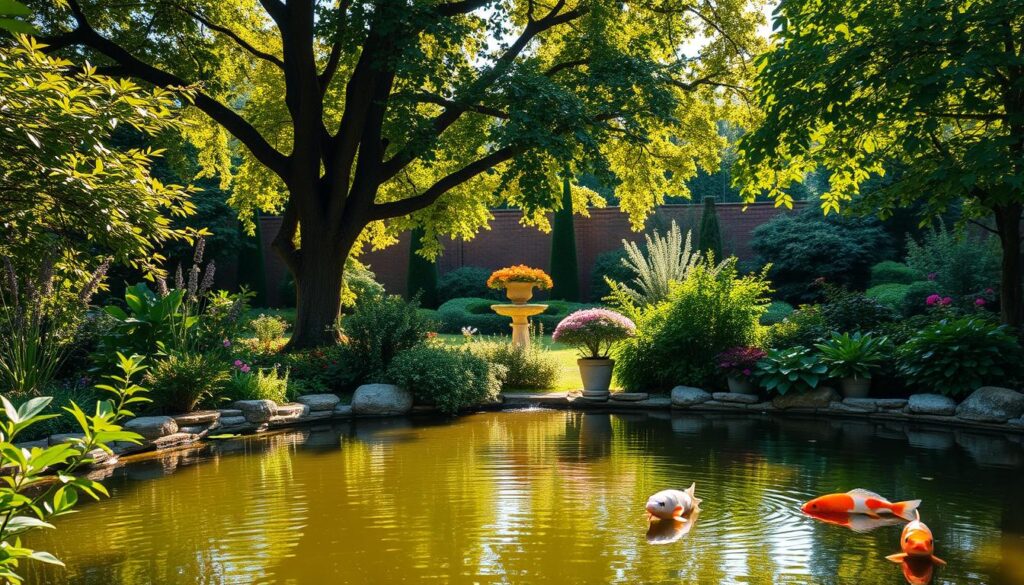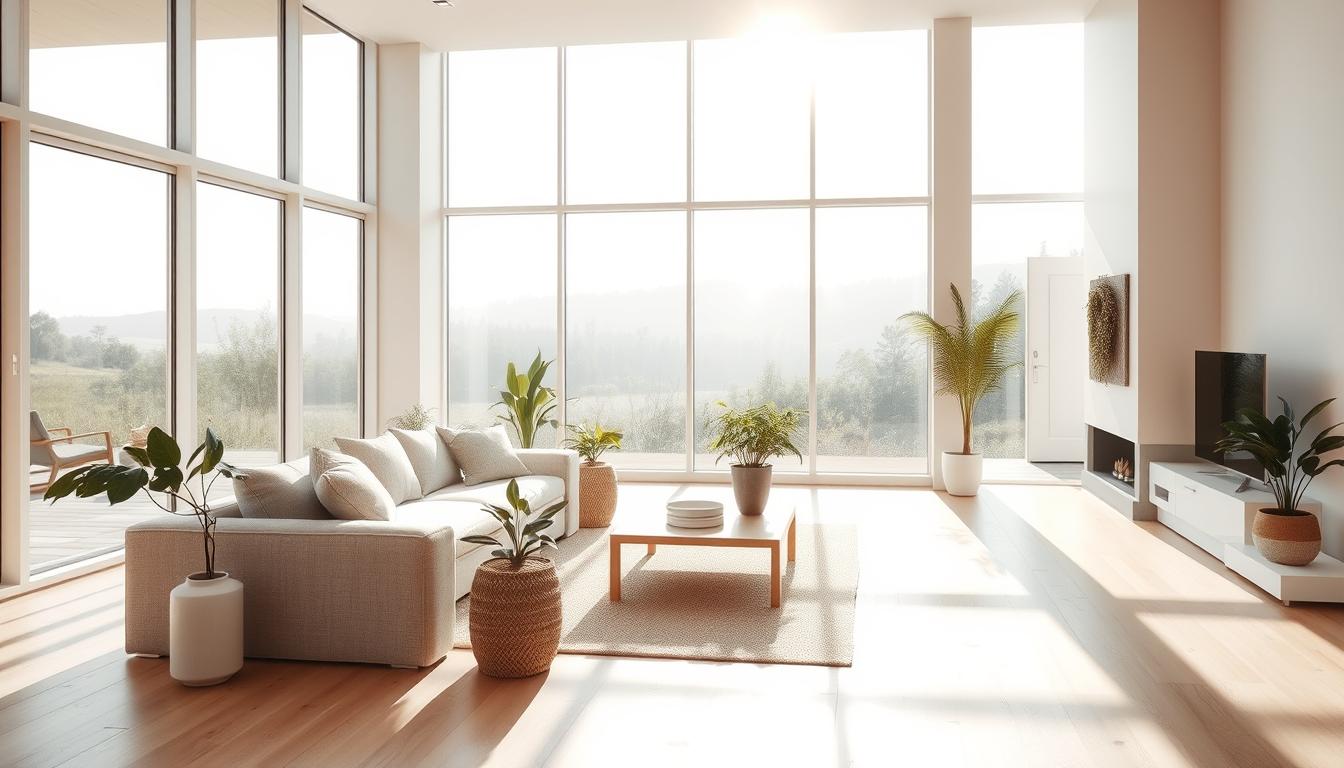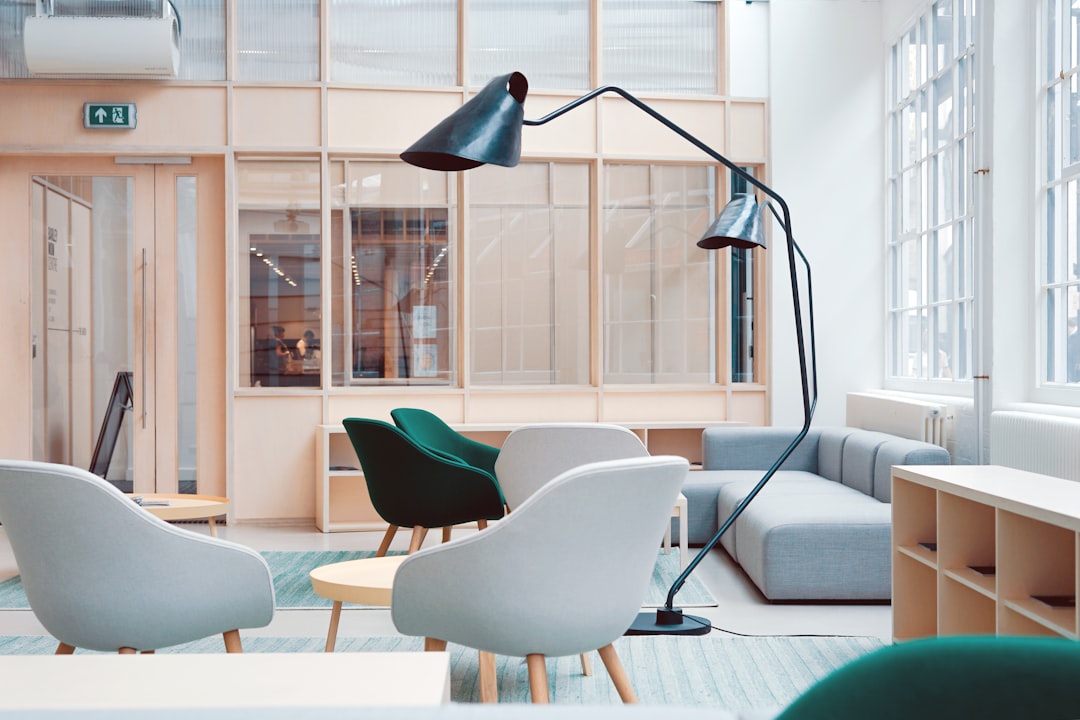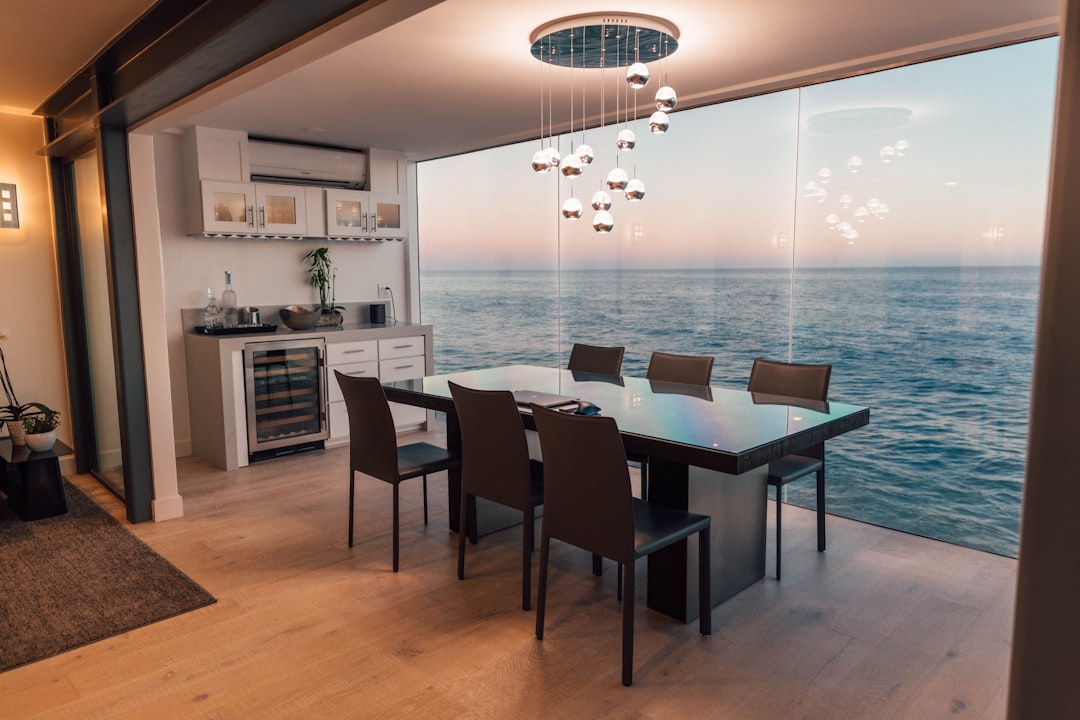Being in the sun boosts our mood and helps us work better. Since we’re inside more, using interior design with natural light is key for our health. Natural light makes any room feel bigger and more inviting.
By using more natural light at home, we make our space look better and feel healthier. It’s about blending the indoors with the outdoors. This lets natural light brighten up our homes.
Key Takeaways
- Natural light boosts mood and productivity.
- Incorporating natural light enhances the aesthetic appeal of a home.
- Maximizing natural light has numerous health benefits.
- It’s essential for creating a harmonious indoor-outdoor balance.
- Natural light makes spaces feel more welcoming and spacious.
The Importance of Natural Light in Interior Design
Natural light is key in interior design. It affects our mood, energy use, and property value. It’s more than a design element; it’s a game-changer for our spaces.
Enhances Mood and Well-Being
Being in natural light boosts serotonin, which lifts our mood and well-being. Experts say natural light makes spaces healthy and happy.
“Light is a powerful mood elevator, and its absence can lead to feelings of lethargy and depression.”
By using natural light, we make spaces that are not just pretty but also good for our minds.
Increases Energy Efficiency
Using natural light cuts down on artificial lighting, saving energy. This means lower bills and a greener lifestyle. Homes with lots of natural light use less energy than those with artificial lights.
| Benefits | Description | Impact |
|---|---|---|
| Reduced Energy Consumption | Less reliance on artificial lighting | Lower utility bills |
| Improved Mood | Boosts serotonin levels | Enhanced well-being |
| Increased Property Value | Makes properties more attractive | Higher resale value |
Boosts Property Value
Well-lit homes are more appealing to buyers. Their beauty and health perks raise their value. Experts say homes with lots of natural light sell quicker and for more money.
Knowing how important natural light is helps us design better spaces. These spaces are not just lovely but also good for our health and the planet.
Tips for Maximizing Natural Light in Your Home
Adding natural light to your home can change how it feels. A few smart design choices can make your home brighter and more welcoming. This can make your living space feel more open and inviting.
Use Light-Colored Walls and Furnishings
Light-colored walls and furniture are a simple way to brighten up your home. Light colors reflect light, making rooms look bigger and brighter. Try painting your walls a light color and picking furniture with light finishes for a fresh, airy look.
Incorporate Mirrors to Reflect Light
Mirrors are great for adding more light to your space. Place mirrors opposite windows to reflect natural light into the room. This trick not only brings in more light but also makes your room seem bigger.
Choose Sheer Window Treatments
The right window treatments can really help with natural light. Sheer curtains or blinds let light in while keeping things private. Unlike thick drapes, these don’t block light, keeping your rooms bright and welcoming.
| Tip | Description | Benefit |
|---|---|---|
| Light-Colored Walls | Paint walls a light shade | Makes rooms appear brighter and more spacious |
| Mirror Placement | Place mirrors opposite windows | Reflects natural light, making rooms feel larger |
| Sheer Window Treatments | Use sheer curtains or blinds | Allows natural light to filter in while maintaining privacy |
For more ideas on brightening your space, check out our article on Brighten Your Space with Natural Light Interior. By using these tips, you can make your home brighter and more inviting. It will feel more connected to the outdoors.
Best Window Styles for Optimal Light
The right windows can change your home by bringing in lots of natural light. Choosing the right window styles can make your rooms brighter and more welcoming.
Large Windows and Sliding Glass Doors
Large windows and sliding glass doors are great for getting more natural light. They let you see outside clearly and bring sunlight into your home. For example, big windows in your living room can make it feel bigger and brighter.
For more ideas on using natural light in your home, check out Cozy Nest Plans.
Clerestory Windows
Clerestory windows are a smart choice for natural light. They are placed high on walls, letting sunlight in without losing privacy. They work well in places where regular windows don’t fit.
Skylights and Roof Windows
Skylights and roof windows light up your home from above. They’re perfect for small spaces like hallways or bathrooms. Skylights make your home feel brighter and more inviting.
Here’s a comparison of these window styles in terms of their benefits:
| Window Style | Benefits | Ideal Placement |
|---|---|---|
| Large Windows | Maximizes natural light, provides unobstructed views | Living rooms, bedrooms |
| Clerestory Windows | Brings in natural light without compromising privacy | Bathrooms, hallways |
| Skylights and Roof Windows | Illuminates areas with limited wall space | Hallways, bathrooms, kitchens |
Knowing about different window styles helps you choose the best for your home. Whether you pick large windows, clerestory windows, or skylights, each one can change how bright and welcoming your home feels.
Designing Open Spaces for Light Flow
To get the most out of natural light, we need to design open spaces. These areas not only look better but also help light flow better.
One key strategy is to remove unnecessary walls. This makes our homes feel more open and airy. It lets natural light reach further into our living areas.
Remove Unnecessary Walls
Removing walls between rooms, like the kitchen and living room, boosts light. It makes the space brighter and more open.
But first, check if the wall is load-bearing. A pro can help figure this out.
Use Open Shelving
Open shelving keeps spaces open while offering storage. It lets light move freely, making rooms feel less dark.
Open shelving in kitchens or living rooms also adds style. It makes the area feel more open and airy.
Create Zones with Furniture
Using furniture to create zones in a room is smart. It defines areas without blocking light. This way, we get a bright and useful space.
For instance, a sofa or console table can separate a living area from a dining space. It keeps the space feeling open.
| Design Element | Benefit | Example |
|---|---|---|
| Removing Unnecessary Walls | Enhances natural light flow and creates a sense of openness | Removing the wall between the kitchen and living room |
| Using Open Shelving | Maintains openness and provides storage | Open shelving in the kitchen or living room |
| Creating Zones with Furniture | Defines different areas without obstructing natural light | Using a sofa to delineate a living area |
By using these strategies, we can make our homes brighter and more welcoming. This is thanks to better natural light.
The Role of Interior Colors in Light Reflection
Choosing the right colors for our interiors is key to using natural light well. The right colors can make a room feel brighter and more open. The wrong ones can make it feel dark and cramped.
The colors we pick can greatly affect how light spreads in a room. Light colors reflect light, making rooms look brighter and more open. Dark colors, on the other hand, absorb light, making spaces feel smaller and more closed in.
Understanding Light Reflectance Value (LRV)
Light Reflectance Value (LRV) measures how much light a surface reflects. It’s crucial for understanding how colors affect a room’s brightness. LRV values range from 0 (absorbs all light) to 100 (reflects all light).
When picking paint, knowing the LRV helps make better choices. Colors with high LRV values reflect more light, making rooms brighter.
Best Paint Colors for Bright Spaces
Choosing the right paint colors can really brighten a room. Soft whites, creams, and light pastels are great choices because they reflect a lot of light. This makes spaces feel larger and brighter.
- Soft whites and creams for a clean, airy feel
- Light pastels for a subtle pop of color
- Pale grays for a neutral, sophisticated look
Accent Walls vs. Neutral Tones
Neutral tones can make a room feel open and bright. But, accent walls can add depth and character. The trick is to balance them well.
Using a bold color on one wall can create a focal point. But, make sure the other walls are light to keep the space feeling bright.
By carefully choosing our interior colors and understanding LRV, we can make spaces that feel bigger and brighter. And we can make the most of the natural light available.
Landscaping That Enhances Natural Light
Strategic landscaping can greatly improve the natural light in your home. By planning your outdoor spaces well, you can make your home brighter and more welcoming.

Plant Placement and Tree Selection
The trees and plants you pick can greatly affect your home’s natural light. Deciduous trees offer shade in summer but let sunlight through in winter when they lose their leaves.
When picking trees, think about their size when they’re fully grown. Planting them far from your home can reduce their shadow. For closer spots, choose smaller plants or shrubs that won’t block sunlight.
Garden Design to Minimize Shadows
A well-designed garden can cut down shadows and let more sunlight in. Think about your garden’s layout and how it affects your home’s windows and doors. Orient your garden to let sunlight reach your windows, mainly during peak hours.
Using a design with open spaces and paths can also reduce shadows. Stay away from dense plants near windows, as they block sunlight. Instead, pick plants that are less dense or have an open structure.
Outdoor Living Spaces
Outdoor living areas can be designed to boost natural light by reflecting it into your home. Light-colored paving and decor can reflect sunlight towards your windows.
Also, think about the color and reflectivity of your outdoor furniture and decor. Light colors reflect sunlight, while dark colors absorb it. By designing your outdoor spaces thoughtfully, you can brighten up your home’s interior.
Innovative Lighting Solutions to Complement Natural Light
Innovative lighting solutions are key in interior design, blending with natural light. They help make a room’s ambiance better and cut down on energy use from non-renewable sources.
Layered Lighting Design
Layered lighting design uses various light sources for a beautiful and useful space. It includes ambient lighting for general light, task lighting for specific needs, and accent lighting for highlights.
This method creates a balanced lighting scheme that works well with natural light. For example, dimmable LED lights let us change the light level based on the time and room use.
Smart Lighting Systems
Smart lighting systems are a modern way to manage light at home. They can be controlled with smartphones or voice assistants, making it easy to adjust the lighting.
These systems can mimic natural daylight, helping our body clocks. They also save energy by turning off lights when not needed or adjusting brightness with natural light.
Decorative Fixtures
Decorative fixtures do more than just light up a room; they add to its look. Choosing fixtures that match the room’s style can really improve the feel of the space.
There’s a wide variety of decorative fixtures out there, from modern to vintage. Picking ones that show our personal taste can make a room feel more like home.
Seasonal Considerations for Light
To keep our homes bright and welcoming all year, we must think about how seasons change natural light. As the Earth tilts, sunlight’s angle and strength shift, affecting how much light our homes get.
Adjusting Drapery for Summer and Winter
Changing our window treatments is a simple way to adapt to seasonal light changes. In summer, when the sun is high, light-colored, sheer drapery filters intense sunlight. This reduces heat while keeping rooms bright. In winter, heavier, insulated drapes help keep warmth in while letting light in.
Tips for Seasonal Drapery Adjustment:
- Use thermal or blackout curtains in winter to minimize heat loss.
- Switch to lighter, sheer fabrics in summer to allow for diffused natural light.
- Consider motorized drapes for ease of adjustment with the changing seasons.
Utilizing Seasonal Decor to Enhance Light
Seasonal decor also plays a big role in using natural light. In winter, when light is scarce, light-colored decorations reflect what little light there is, making rooms brighter. In summer, when light is plentiful, bright colors and reflective surfaces add to a room’s brightness and energy.
Seasonal Decor Ideas to Enhance Natural Light:
- Use light-colored throw pillows and blankets in winter.
- Incorporate reflective decorative items, like metallic vases or mirrors, to bounce light around the room.
- Choose lighter-colored wall art and rugs to maintain a bright atmosphere.
Planning for Seasonal Sun Paths
Understanding and planning for the sun’s path changes can greatly impact natural light in our homes. By studying the sun’s path at different times, we can make smart choices about where to place windows, how to landscape, and design interiors to maximize light.
Considerations for Planning Around the Sun’s Path:
| Season | Sun’s Path | Design Considerations |
|---|---|---|
| Summer | High trajectory | Use shading devices or overhangs to control direct sunlight. |
| Winter | Lower trajectory | Maximize south-facing windows for increased sunlight exposure. |
| Spring/Fall | Moderate trajectory | Adjust window treatments to balance light and privacy. |
By keeping these seasonal factors in mind and making the right adjustments, homeowners can keep their homes bright, welcoming, and energy-efficient all year.
Case Studies of Successful Natural Light Designs
Using natural light in interior design boosts energy efficiency and improves the feel of a space. We’ll look at examples where natural light was successfully added to different places.
Residential Spaces
Spaces for living that use natural light are welcoming and healthy. For example, a modern home in California had big windows and skylights. This let in lots of natural light, cutting down on the need for artificial lights during the day.
Key Features: Large windows, skylights, light-colored interiors.
Commercial Interiors
Commercial areas also gain a lot from natural light. An office in New York had clerestory windows and a glass atrium. This brought natural light inside, making employees more productive and happy.
Notable Elements: Clerestory windows, glass atrium, open floor plan.
Eco-Friendly Projects
Eco-friendly projects often focus on natural light to save energy. A sustainable community center in Oregon used solar tubes and big windows. This showed how natural light can be used well in green design.
| Project Type | Key Features | Benefits |
|---|---|---|
| Residential | Large windows, skylights | Reduced energy consumption, enhanced ambiance |
| Commercial | Clerestory windows, glass atrium | Increased productivity, improved well-being |
| Eco-Friendly | Solar tubes, large windows | Minimized energy consumption, sustainable design |
These examples show how natural light can be used in many designs. By learning from these, designers and homeowners can make spaces that look good, are sustainable, and healthy.
Challenges and Solutions of Using Natural Light
Natural light can make a space look better and work better. But, there are challenges like glare, heat, privacy issues, and architectural limits.
Dealing with Glare and Heat
Managing glare and heat from natural light is a big challenge. Big windows and skylights can cause glare or too much heat. The right window treatments can help solve this.
- Window Films: Window films can cut down glare and block UV rays without blocking your view.
- Smart Glass: Smart glass can change from clear to opaque with a button press, controlling light and heat.
- Awnings and Overhangs: Awnings or overhangs can block sunlight during the hottest times, keeping your space cooler.
Privacy Concerns and Solutions
Keeping privacy while enjoying natural light can be tough. Big windows and glass doors make a space feel open but can lose privacy.
| Solution | Description |
|---|---|
| Frosted Glass | Frosted or obscured glass lets light in but keeps views private. |
| Sheer Curtains | Sheer curtains or drapes filter light and offer privacy when needed. |
| Plantation Shutters | Plantation shutters give you control over light and privacy. |
Architectural Limitations
Building design can limit how much natural light you can use. But, there are ways to bring in more light.
Light Tubes or Sun Tunnels are smart ways to bring natural light from the roof into spaces without windows.
Knowing the challenges and using the right solutions can help you enjoy natural light without its downsides.
Conclusion: Embrace Natural Light in Your Home Design
Incorporating natural light into your home design can greatly improve your living space. By using various strategies, you can make your home brighter, healthier, and more eco-friendly.
Key Takeaways
We’ve talked about many ways to bring more natural light into your home. This includes using light-colored walls and furniture, mirrors to bounce light, and sheer curtains. We also looked at how different windows, open layouts, and landscaping can help.
Putting Ideas into Action
We suggest trying out these ideas to see what works for you. Begin by checking how much light your home gets now and where it’s lacking. You might want to talk to a pro to get advice on the best natural light ideas for your home.
Next Steps
By using natural light in your home design, you can feel better, save energy, and even increase your home’s value. Start making your home brighter today by looking into all the ways to use natural light.



